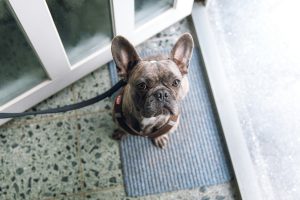
Why tidying your entryway matters
Your entryway is more than a place to kick off your shoes — it’s the mood-setter for your entire day.
It’s the first space to greet you when you come home and the last one you see when you head out.
When it’s calm and organized, you feel grounded, prepared, and yes — even a bit joyful.
When it’s cluttered, your morning routine can unravel faster than a wool scarf on a windy day in Rotterdam.
Historically, the hall was the heart of the home. As Bill Bryson noted in At Home: A Short History of Private Life, the “hall” in early English homes was the main living space — where people cooked, ate, and sometimes slept. In a sense, our modern entryways still carry that spirit of “home base” — a place that sets the tone for all the coming and going that shapes our lives.
A Little Hilversum Magic
Last year, around this time, I met with my Dutch KonMari colleagues for a delicious lunch and idea exchange. One colleague spoke about applying Feng Shui to the entryway, saying it could attract good fortune and fresh energy.
Having just moved to the charming town of Hilversum, I figured — why not? A little good fortune sounded lovely.
Back home, I tackled my one-square-metre entryway (fine… 1.5 if we’re generous). I couldn’t change the layout, but I could declutter. I found better homes for my shoes, added a small step stool to reach the coat rack, tucked away my yoga mat, and hung my umbrella and bike bags within easy reach.
It took less than an hour, but it changed how the space felt — lighter, calmer, more welcoming.
And while my analytical brain couldn’t prove the Feng Shui connection, I noticed something shift in myself: I felt ready for new beginnings.
How to Organize Your Entryway for Everyday Success
1. Start with a Joy Check
Begin by discarding first — KonMari-style.
Group items by type, then hold each one and ask: Does this spark joy or simply take up space?
Donate, sell, or give away the rest.

2. Curate your Coat Rack
Outerwear multiplies quickly — before you know it, your hallway resembles a museum of coats.
Keep only what you actually wear this season. Move what belongs elsewhere — gym bags, reusable totes, or that random screwdriver “waiting to go to the toolbox” for three months.
3. Contain — But Don’t Bury
Use bins to corral small things like hats, gloves, and scarves — it’s helpful if they’re clear, shallow, or divided.
A deep bin is like a black hole for single mittens and mystery keys.
If your bins sit on a high shelf, handles make them easier to grab.
And lids? Only if you’re stacking. Otherwise, skip them — they just slow you down (and no one enjoys wrestling with a lid when they’re in a hurry).
4. Keep It Practical — for People and Pets
Add a few sturdy wall hooks for the everyday essentials: keys, bike bags, and your dog’s leash.
If you share your home with a furry friend, create a small “walk station” by the door — a spot for leash, collar, poop bags, and a pouch of treats. That way, when the skies suddenly open up (as they tend to in the Netherlands), you’re not scrambling for the dog lead while your pup is doing impatient circles by the door.

5. Create a Functional Drop Zone
Your drop zone isn’t just a pretty bowl for keys — it’s a small command center.
It’s where you sort your bag, remove what you no longer need (last week’s grocery receipts or the mystery snack wrapper), and make sure you have what you do need for the day.
Think of it as giving your bag a mini “joy check” each morning.
You’ll walk out feeling lighter — both in mind and body, literally!
For me, it’s often the “one-time” items that linger — the measuring tape from last week’s project or the portable charger from that long train trip — quietly turning my bag into unintentional strength training.
6. Add Joy, Not Just Stuff
A mirror near the door? Excellent for last-minute checks before facing the world.
A small rug or rubber mat? Thoughtful for guests with wet shoes.
A freestanding coat rack or umbrella stand? Maybe— these can be bulky; do they truly spark joy?
In a small space, every item should justify the real estate it occupies.

7. The 70% Full Rule
Whether it’s a coat closet, shoe rack, or umbrella stand, aim to fill it no more than about 70% full.
That breathing room makes it easier to see what you have, prevents cramming, and keeps your entryway feeling spacious rather than stressed.
When your hallway is literally and visually uncluttered, you start and end your day that way too.
Coming and Going with Ease
When I later moved to my apartment in Amsterdam, I expanded the concept by adding a drop zone just past the front door — a small tray for keys, a hook for wet coats, and a shelf to unload my bag as I sorted through it.
It’s not just functional — it feels grounding.
Because every time I step through the door, I’m reminded that home is a space I’ve intentionally shaped to support my life, not the other way around.
And truly, a tidy entryway is a small but mighty form of self-care.
It’s your daily “welcome home” — and your best foot forward.
A calm, intentional entryway sets the tone for your whole home — and your day.
If you’d like help creating yours, I offer personalized KonMari tidying sessions (both virtual and in-person).
Start your journey to a more joyful, clutter-free home.
I’m Sheila, your opruimcoach/professional organizer. Each month I’ll drop fresh organizing inspiration, smart tips, and a nudge to let go of what doesn’t serve you. Sign up now and get organizing inspiration without adding to your clutter pile!
